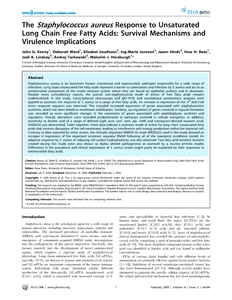Kenny, JG; Ward, D; Josefsson, E; Jonsson, IM; Hinds, J; Rees, HH; Lindsay, JA; Tarkowski, A; Horsburgh, MJ
(2009)
The Staphylococcus aureus Response to Unsaturated Long Chain Free Fatty Acids: Survival Mechanisms and Virulence Implications.
PLOS ONE, 4 (2).
e4344.
ISSN 1932-6203
https://doi.org/10.1371/journal.pone.0004344
SGUL Authors: Hinds, Jason Lindsay, Jodi Anne
![[img]](https://openaccess.sgul.ac.uk/302/1.hassmallThumbnailVersion/pone.0004344.pdf)  Preview |
|
["document_typename_application/pdf; charset=binary" not defined]
Published Version
Download (684kB)
| Preview
|
Abstract
Staphylococcus aureus is an important human commensal and opportunistic pathogen responsible for a wide range of infections. Long chain unsaturated free fatty acids represent a barrier to colonisation and infection by S. aureus and act as an antimicrobial component of the innate immune system where they are found on epithelial surfaces and in abscesses. Despite many contradictory reports, the precise anti-staphylococcal mode of action of free fatty acids remains undetermined. In this study, transcriptional (microarrays and qRT-PCR) and translational (proteomics) analyses were applied to ascertain the response of S. aureus to a range of free fatty acids. An increase in expression of the sigma(B) and CtsR stress response regulons was observed. This included increased expression of genes associated with staphyloxanthin synthesis, which has been linked to membrane stabilisation. Similarly, up-regulation of genes involved in capsule formation was recorded as were significant changes in the expression of genes associated with peptidoglycan synthesis and regulation. Overall, alterations were recorded predominantly in pathways involved in cellular energetics. In addition, sensitivity to linoleic acid of a range of defined (sigB, arcA, sasF, sarA, agr, crtM) and transposon-derived mutants (vraE, SAR2632) was determined. Taken together, these data indicate a common mode of action for long chain unsaturated fatty acids that involves disruption of the cell membrane, leading to interference with energy production within the bacterial cell. Contrary to data reported for other strains, the clinically important EMRSA-16 strain MRSA252 used in this study showed an increase in expression of the important virulence regulator RNAIII following all of the treatment conditions tested. An adaptive response by S. aureus of reducing cell surface hydrophobicity was also observed. Two fatty acid sensitive mutants created during this study were also shown to diplay altered pathogenesis as assessed by a murine arthritis model. Differences in the prevalence and clinical importance of S. aureus strains might partly be explained by their responses to antimicrobial fatty acids.
| Item Type: |
Article
|
| Additional Information: |
©2009 Kenny et al. This is an open-access article distributed under the terms of the Creative Commons Attribution License, which permits unrestricted use, distribution, and reproduction in any medium, provided the original author and source are credited. |
| Keywords: |
Animals, Fatty Acids, Unsaturated, Female, Genes, Bacterial, Mice, Mice, Inbred Strains, Polymerase Chain Reaction, Proteomics, Staphylococcus aureus, Transcription, Genetic, Up-Regulation, Virulence, Science & Technology, Multidisciplinary Sciences, Science & Technology - Other Topics |
| SGUL Research Institute / Research Centre: |
Academic Structure > Infection and Immunity Research Institute (INII) |
| Journal or Publication Title: |
PLOS ONE |
| ISSN: |
1932-6203 |
| Related URLs: |
|
| Web of Science ID: |
WOS:000265483200014 |
| Dates: |
| Date |
Event |
| 2009-02-02 |
Published |
|
  |
Download EPMC Full text (PDF)
|
 |
Download EPMC Full text (HTML)
|
| URI: |
https://openaccess.sgul.ac.uk/id/eprint/302 |
| Publisher's version: |
https://doi.org/10.1371/journal.pone.0004344 |
Statistics
Item downloaded times since 30 Apr 2012.
Actions (login required)
 |
Edit Item |



